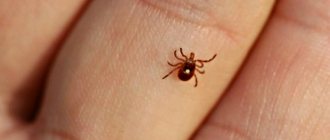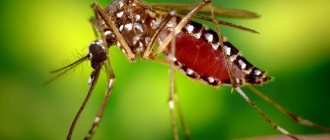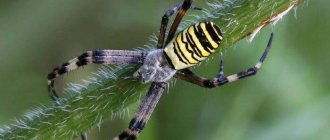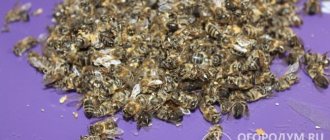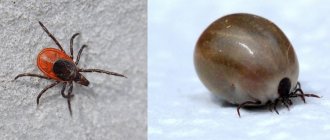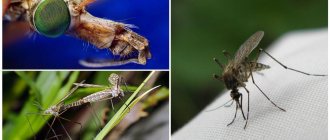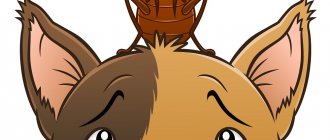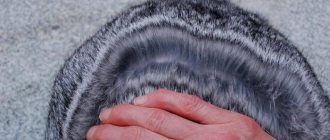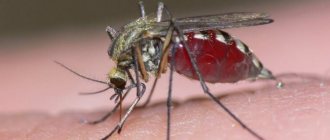Fleas - description, characteristics, structure. What do fleas look like?
The flea's body length is only 1-5 mm, but females of certain species, after intensive feeding, reach a length of more than 1 cm due to their hypertrophied abdomen. The length of a fertilized female can be 1.5 cm. The largest fleas that parasitize moose have a body length of up to 1 cm.
The flea's body consists of a small head and abdomen, covered with a durable chitinous covering. If you look at a flea under a microscope, you can see how the insect’s body is flattened laterally, somewhat reminiscent of a shrimp. But this body shape is evolutionarily justified and allows the parasite to move unhindered in the feathers, thick fur of the host, in the substrate of burrows and nests, or in the folds of clothing.
SEM image of a flea in artificial flowers
The color of a flea can be yellowish, reddish, dark brown and even almost black.
The flea does not have wings, and this is no coincidence: a winged parasite is easier to crush, and the presence of adaptations for flight could complicate motor activity.
Thanks to 3 pairs of long, strong limbs, fleas often move by jumping, which is ensured by powerful pushes of the second and third pair of legs. Some types of fleas have relatively short legs and practically never leave the host's body. Each limb consists of 5 segments and ends in sharp forked claws.
The easy movement of the flea is also facilitated by numerous spines and bristles scattered throughout the body, as well as jagged combs and ctenidia located on the head. This structure of the flea is a kind of protection for the insect: all attempts to comb, pull out or bite the flea will end in failure. The only way to destroy a parasite is to crush it with a fingernail on a hard surface.
There are simple eyes on the head of the flea, and antennae grow behind them, with the help of which males hold females during mating. In a calm state, the flea's antennae are immersed in small antennal fossae.
Fleas have a piercing-sucking type of oral apparatus, which is characterized by the transformation into stylets of epipharynges (unpaired stylet) and lacinia (paired stylets), articulated with maxillary lobes. The parasite bites through the host's skin, widens the wound and releases saliva, which prevents blood clotting. The flea then plunges its body into the wound to reach the blood vessel. When feeding, fleas fill their stomachs with blood, which can become very swollen.
A distinctive feature of the structure of fleas is the presence of a pygidium, a special sensory organ located in the back of the abdomen. Tactile hairs covering the pygidium sensitively detect the slightest vibrations in the air and signal danger.
The reproductive organs of a female flea consist of oviducts, ovaries and a spermatic receptacle, which resembles a curved flask. Males are endowed with a copulatory organ - the genital claw.
Nutritional Features
Due to the presence of a piercing-sucking mouthpart, fleas lead a parasitic lifestyle. They feed only on blood. Compared to other insects, blood protein is the main nutrition at any stage of flea development.
After piercing the skin, the flea secretes a special enzyme. It makes blood clotting slower.
How long do fleas live?
On average, fleas live from several months to 3 years. The lifespan of a flea depends on its species and ambient temperature. At elevated temperatures (when the air is heated to 30-35 degrees), the life cycle of a flea is reduced by almost 40%, and at lower temperatures, on the contrary, it increases, since the development of the flea slows down.
The development cycle of a human flea from egg to imago (adult) lasts from approximately 16 days to one year. Cat fleas live on average 2 years, dog fleas live up to one and a half years.
A flea can go without food for quite a long time (without an animal or without a person): the insect easily tolerates hunger for 30-40 days, and according to some reports, for several months. In this case, the parasite does not go into suspended animation, but only reduces its activity and stops reproducing.
For your information
There are some other interesting facts about fleas.
In ancient times, flea races were very popular. But it has been scientifically proven that parasites cannot be trained - circus performers played on their reflexes. The “flea market” came to us from France. It sold all unnecessary, worn things, infested with fleas, moths and other parasites. In the Middle Ages, ladies and gentlemen resorted to various tricks to fight fleas: there were special sticks for scratching high hairstyles and medallions for catching fleas. Even silk underwear came into use, not least because fleas slipped off it. According to the interpreter of dreams, dreams of a flea always mean minor troubles.
Where do fleas live?
Strong, hardy and very tenacious, fleas are found on all continents, including Antarctica. Most flea species live in temperate and subtropical climate zones of Europe, Asia and North Africa. Fleas are active at any time of the year, and their habitats are tied to the nests and burrows of warm-blooded animals living underground (gerbils, jerboas, gophers and other rodents), on the ground (wild and domestic animals: cats, dogs, rats, horses, cows , rams, camels, etc.) and above ground (birds, squirrels). Some fleas live on humans.
The main hosts of most flea species are mammals, whose life at any time of the year is inextricably linked with the presence of shelter. Animals that periodically live in burrows and nests are less susceptible to flea attacks. Parasites do not live on the host’s body permanently, but jump on to suck blood and then descend into the nest’s litter. Some fleas are associated with artiodactyls and marsupials, which generally do not build or use nests and burrows. These types of fleas are stationary parasites that do not leave their hosts.
Fleas of both sexes suck blood, and the process can last from 1 minute to several hours. Fleas of some species are saturated with blood in reserve; as a result, they do not have time to digest everything, and the remaining blood is excreted in excrement.
Species of fleas that need frequent feeding live on the animal’s body constantly, and in between meals they wander in the fur of the owner. Fleas, which do not have the need to frequently suck blood, spend most of their lives in the substrate of the host's nest. In the absence of a food source, insects can starve for several months. Most flea species do not have a specific host choice and can exist on different animal species, with the exception of bat fleas.
Spreading
Fleas are found on all continents (even in Antarctica: Glaciopsyllus antarcticus). Fleas are mostly associated with temperate and subtropical climatic zones, therefore the bulk of species and genera are distributed in the East Asian, Central Asian, Western American, Patagonian, Papuan and East African zoogeographical subregions. The largest number of species was found in the Palaearctic (892 species from 96 genera), Nearctic (299, 68), Neotropic (289, 55) and Afrotropic (275, 43). The family Ischnopsyllidae is cosmopolitan. The families Hystrichopsyllidae and Ceratophyllidae are distributed almost worldwide. The families Stephanocircidae, Lycopsyllidae, Macropsyllidae, and Malacopsyllidae are found only in the southern hemisphere. Africa is characterized by the families Xiphiopsyllidae and Chimaeropsyllidae, and Australia by Lycopsyllidae and Macropsyllidae.
Types of fleas, photos and names
Currently, there are from 15 to 22 families of fleas, including many species:
- Human flea (Pulex irritans)
one of the most common types of fleas, living everywhere. The brownish insect, 1.6-3.2 mm long, is capable of jumping 30 cm in height and up to half a meter in length. Unlike most flea species, the human flea does not have thoracic or cephalic teeth. The insect parasitizes humans, domestic and wild animals, carries the plague pathogen, and causes pulicosis (an itchy skin lesion). Human fleas can also live on cats, dogs, horses, that is, on animals that have constant contact with humans. The total duration of blood digestion in a human flea is 5-6 hours. In this case, the duration of blood sucking can vary from several seconds to 20 minutes.
Human flea (female on the left, male on the right)
Photo by: Katja ZSM
- Cat flea (Ctenocephalides felis)
found on all continents and is a carrier of plague, brucellosis and other infections. It feeds on the blood of cats, dogs, rodents, many other animals, as well as humans. Larval development occurs in animal fur and litter. The average size of a flea is 0.75-5 mm, the body length of a female with eggs reaches 1.6 cm. Adults have a short proboscis and a flat forehead. The lifespan of a cat flea ranges from 3 months to 3 years.
Photo by: Katja ZSM
- Dog flea (Ctenocephalides canis)
a closely related species of cat flea, also distributed across all continents. It parasitizes dogs, cats, wild animals and humans, carrying flatworms, trypanosomes and many other parasites. In a dormant form it stores the causative agents of plague, leprosy bacillus and Marseilles fever. Flea bites can cause ctenocephalosis. The dimensions of a dog flea are identical to that of a cat (from 0.75 to 0.5 mm). The female lays eggs in animal litter or fur. The life cycle of a dog flea is about 1.5 years.
Photo by: Luis Fernández García
Dog flea (male on the left, female on the right)
Photo by: greenzaku
- Southern rat flea (Xenopsylla cheopis)
a particularly dangerous type of flea, a carrier of plague, mouse and rat tapeworm. It is found throughout the world, but to a greater extent in countries with tropical and subtropical climates. The female flea has a body length of 1.8 to 2.7 mm, males grow from 1.4 to 2 mm in length. The color of the flea can be light or dark brown. Fertilized females lay eggs in the nests of rats and gerbils - animals whose blood they feed on.
Photo by: Rattenfloh
Rat fleas (male left, female right)
- Tien Shan flea , also known as alakurt (Vermipsylla alakurt)
lives exclusively in the Tien Shan valleys and the Baisaur mountains. Translated from Kyrgyz, alakurt means “variegated worm.” Indeed, fertilized females swell excessively, but not laterally, but in length, and become like worms. At the same time, the abdominal segments move away from each other, which is why the “worm” becomes motley. The length of adult males is about 4 mm, non-bloated females are 4.5-5 mm, and the body of the fleas is black. Alakurt fleas appear only in winter, climbing onto livestock from frozen grass. Horses, rams, camels, and cows are attacked. The parasites quickly increase in size, changing their color from black to white, and sit on the animal’s body very firmly, like ticks. In especially abundant years with alakurt, a significant part of the cattle exhausted by bloodsuckers does not survive until spring.
Tien Shan flea (male on top, female on bottom)
- Penetrating flea , also known as sand flea or Brazilian ground flea (Tunga penetrans)
the parasite is from Haiti, Brazil and Guiana, from where in the 19th century it was introduced to Africa, India and Pakistan, where it successfully took root. Individuals of both sexes have a body length of only 1 mm and can jump to a height of up to 35 mm. The body of an unfertilized female flea is oval-shaped and red-brown in color with a white spot in the middle. The fertilized female swells up like a ball and becomes the size of a white pea with a diameter of up to 1 cm. The usual habitat of the ground flea is dry grass, from where the parasite jumps on wild and domestic animals, birds and humans. Males bite the victim and drink its blood. Female fleas burrow under the skin of animals' feet and under human toenails and fingernails, leading to inflammation, tetanus, and sometimes gangrene, amputation, and even death. Sand fleas also lead to a disease called sarcopsillosis, or tungiasis.
Photo by: Gilberto M Palma
- Flea Glaciopsyllus antarcticus
an endemic species whose representatives live exclusively in Antarctica. The body length of females is 4 mm, males - 3 mm. These fleas live in bird nests and parasitize snow petrels, chinstrap petrels, silver petrels, Cape pigeons and Wilson's storm petrels.
- Malacopsylla grossiventris
a type of flea that parasitizes mammals in South America: dwarf, long-haired, nine-lined armadillos, rodents, as well as other species of wild animals. A distinctive feature of this species and its related Phthiropsylla agenoris are the largest eggs ever studied by scientists. Their size is 719-800 µm, while the size of other flea eggs does not exceed 600 µm.
The most common types of parasites
It is quite difficult to talk in detail about what kind of fleas there are, because biologists identify almost 2000 species. At the same time, all types of fleas are very similar in appearance to each other, which means that it is difficult for an ignorant person to differentiate them. It is enough for any pet owner to be able to distinguish between three types of parasites.
- Dog flea.
Scientific name: Ctenocephalides Canis. The parasites are dark red in color and are distinguished from other types by the presence of ridges around the mouth and head. Ctenocephalides Canis are also quite large in size. Despite its name, this type of parasite can also infect other animals.
- Cat flea.
Scientific name: Ctenocephalides Felis. Parasites are a uniform dark color, usually black or brown. This type is considered the most resistant to repellents and can affect not only cats, but also rodents and birds.
- Human fleas.
This type is often confused with lice. But in fact, this is a completely different type of parasite, which is scientifically called Pulex irritans. Arthropods do not grow more than 2-3 mm in length and are dark brown in color. It is quite difficult to meet them, because they are carriers of the plague. But in rural areas or on farms you can “catch” representatives of this type of flea.
Flea reproduction and development
Under favorable environmental conditions and air temperatures from 18 to 25 degrees, fleas are able to reproduce all year round. Parasites tolerate extremely low temperatures without harm to health, but stop reproducing. For a successful copulation process, both partners must be well-fed. Before mating begins, the female climbs onto the male’s back and pulls his genital claw into her spermatheca. The movement of the seed into the female's body lasts 10-15 minutes, and mating can last several hours.
Soon after fertilization, the female flea is ready to lay eggs, which occur in small portions. A well-fed female lays 1-2 portions of 4-10 eggs per day, but usually laying occurs once a day or every other day. The process of laying eggs is interesting. The female flea forcefully pushes out the eggs, which are scattered at a considerable distance from each other, which also makes sense: the risk of competition between the hatched larvae is minimized, and most of them will survive, having enough food.
Life cycle of a flea
Fleas are insects with complete metamorphosis; their life cycle consists of several stages:
- egg,
- larva,
- doll,
- imago (adult).
Life cycle of a flea
Flea eggs are white and very small, looking like grains of rice under a microscope.
Sand flea eggs
The development of flea eggs lasts about 14 days, after which translucent worm-like larvae, devoid of legs, are born, which, writhing, burrow into the litter of the host's nest.
The larvae feed on rotting organic matter, desquamated skin epithelium, or the remains of undigested blood in the excrement of the parents.
Photo by: Kalumet
After 3 molts, the flea larva turns into a pupa, surrounding itself with a strong silk-like cocoon.
Depending on weather conditions, the pupal stage lasts from 5 days to several months. In many species of fleas, pupae overwinter, and in some, emergence from the cocoon is timed to coincide with a specific season.
Photo by: Auguste Le Roux
An adult flea emerging from the pupa immediately begins searching for its owner. The active life of an imago lasts on average 1.5-2 months, but at sub-zero temperatures an adult flea can fall into a state of suspended animation for an indefinite period.
House fleas
Household fleas are not at all a separate type of blood-sucking parasite: fleas that have settled in a person’s home are usually considered under this name. But dog, cat, rat, human and even earth (sand) fleas can become such unpleasant and annoying “tenants”. They enter the premises together with their owners, the animals on which they parasitize, or they attack housing from basements and damp cellars, where they often live.
Once in a private household or apartment in a high-rise building, fleas take a liking to the bedding of pets, the pile of carpets and rugs, cracks behind baseboards, soft toys, furniture upholstery, mattresses and linen (it is this fact that has led to the fact that pet fleas are sometimes called bedding or furniture fleas) .
Habitats
Fleas, especially household fleas, prefer to settle in all corners of the apartment. Moreover, they are located at a level of approximately 1.5 meters from the floor level.
Parasites often prefer secluded places:
- baseboards;
- cracks;
- bed;
- Stuffed Toys;
- palace
The ideal place to live is furniture or a kitchen sink.
How to detect fleas in an apartment?
Fleas are fairly small insects, so it is not immediately possible to detect their presence in the house. A good method to confirm the presence of parasites is a regular white sheet. It must be spread on the floor, and if the suspicions were thorough, then after a while dark insects will be noticeable on the light fabric. Another fact that will signal that fleas have appeared in a house or apartment will be red, slightly swollen spots on the skin - marks from flea bites: they appear in the morning, are often arranged in a chain and are unbearably itchy.
How does the feeding process occur in parasites?
While learning everything about fleas, you cannot bypass the feeding process. The parasite pierces the host's skin and then injects saliva through a tube to prevent the clotting process. After which the flea sucks out the required amount of blood. The saliva itself can cause allergic reactions in animals and also cause anemia in kittens.
Few people know that some types of fleas in cats can consume about 15 times their own weight in blood every day.
Naturally, in order to get such an amount of nutritious product, the parasite has to make hundreds of bites a day. This results in slightly raised, swollen, itchy patches with a dark dot in the center (sometimes similar to a mosquito bite). Flea bite marks often appear in groups of two or three spots and can itch for several weeks. But lice usually do not leave bite marks on the scalp. They simply cause itching and cause hair loss. In rare cases, with severe head lice, lice may leave small, red bumps on the scalp, upper neck and shoulders, which may crust over over time.
Flea bites, photo and description
Flea bites cause stabbing pain when the skin is pierced and a strong desire to scratch the affected area. People are usually bitten by a human flea, and at the site of the bite a characteristic swelling appears, like from a cigarette burn. After the flea has eaten and detached itself, the edges of the wound converge, preventing blood from flowing out, and a pinpoint hemorrhage forms under the skin.
Photo credit: Clawed
The main method of protection is the destruction of fleas in the house and apartment, as well as prevention from bites when going outdoors.
What diseases do fleas carry?
Flea bites can be very dangerous because fleas are carriers of disease. Fleas themselves cause two diseases in humans: pulicosis and sarcopsillosis (tungiasis), but insects can carry pathogens of other serious diseases, some of which are deadly. Diseases transmitted by fleas:
- plague (including bubonic);
- typhus (typhus and relapsing);
- encephalitis;
- hepatitis B, C;
- toxocariasis;
- trypanosomiasis;
- tularemia;
- listeriosis;
- pasteurellosis;
- intestinal yersiniosis;
- brucellosis and others.
Danger to humans
Fleas are one of the most dangerous ectoparasites. External danger is the following reactions of the body:
- allergic swelling;
- skin rashes;
- enlarged lymph nodes.
Among other things, the parasite can carry a number of diseases:
- typhus;
- tularemia;
- plague;
- anthrax;
- encephalitis.
In addition, a flea can transmit fungal diseases, listeriosis and salmonellosis to humans.
Flea treatment in the apartment
Modern insecticidal preparations help get rid of household fleas and their larvae even in the most neglected rooms. Due to the fact that fleas are physically unable to eat poisonous bait, means to combat these parasites are available in the form of sprays, powders and suspensions. The principle of action of any flea remedy is to damage the nervous system of insects, which leads to paralysis.
- Aerosol preparations imply large-scale treatment of the premises with the preliminary evacuation of all inhabitants of the apartment, subsequent ventilation and wet cleaning.
- contact powder preparations are scattered under baseboards, cabinets, and behind beds.
- Liquid microcapsule flea products are good because they do not wash out even after cleaning.
The best and most effective home remedies for fleas:
- Spray Raptor “Against crawling insects”: a safe and effective product with a pleasant mint scent. Two cylinders are enough to treat a 1-room apartment;
- Combat spray is an equally effective analogue of Raptor, with the aroma of lemon and mint;
- Sinuzan is a professional flea remedy that reliably protects the room, the only drawback of which is the unpleasant odor;
- Chlorpirimak is used to combat the Colorado potato beetle and leaf beetles, and also perfectly helps to remove household fleas;
- Biorin is a professional drug that requires a serious approach to use. Destroys not only fleas, but also any other parasites;
- Pyrethrum is one of the most popular folk remedies for fleas, approved even by professionals. Powder scattered in corners has a powerful poisonous effect on parasites.
After fleas in a house or apartment are destroyed, it is recommended to carry out wet cleaning by adding a few drops of eucalyptus or ammonia to the water. Under beds and closets you can put dry branches of wormwood, lavender, tansy or bags of pine sawdust, the smell of which fleas do not like.
Where to start the fight
- If you have a pet, start with him. An infected pet should be examined especially behind the ears, face, and belly. Under the wings of birds. And treat it with antiparasitic drugs, of which there are a lot now. Anti-flea drugs are represented by all kinds of shampoos, sprays, drops, tablets and collars.
- If you suspect that fleas came from your neighbors or from the basement or attic, then most likely they are disturbing not only you. Interview your neighbors, if you are not alone, file a collective complaint and contact the SES.
- In your home, you can carry out disinfestation of the basement or attic yourself or call a special service.
- If there are rodents (rats, mice), first get rid of them yourself or by calling a pest control service.
- If you suspect items, shake them outside and wash them at maximum temperature.
Well, we’ve prevented the emergence of new parasites, now let’s take on the ones you have.
Read also: Management, adjacency, coordination
Interesting facts about fleas
- In the 17th-18th centuries, there were so many fleas in the palaces of the French nobility that one of the household items of the court ladies were “flea traps” - small gold boxes like a medallion with a small hole, worn on a chain around the neck, into which fleas could get purely by accident.
- Fleas began to be actively studied and described in the 19th century, and the most authoritative specialist in this field is the English multimillionaire, banker and entomologist Charles Rothschild, who collected the largest collection of parasites, stored in the British Museum.
- The bubonic plague epidemics that killed millions of people in medieval Europe were caused by fleas brought with rats on trading ships.
- Most animals during evolution changed their appearance and structure, adapting to living conditions. But the fossil remains of the parasite, 50 million years old, are practically no different from the modern flea.
- A flea's jump exceeds its body length by 100 times. The tiny parasite is second only to one species of cicada in terms of jumping distance relative to body length. If a person wants to “jump” this record, he will have to make a 160 m long jump.
- The tale of N. S. Leskov about how Lefty shod a steel flea has been continued in our days. A master of microminiatures from Omsk shod an ordinary dried flea with gold shoes, which took him about 7 years. The second specimen of the savvy flea was presented to the Russian President.
Did you like the article? Share with your friends:
